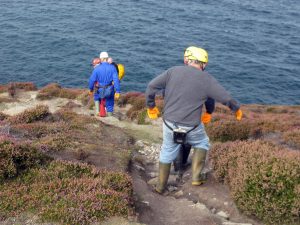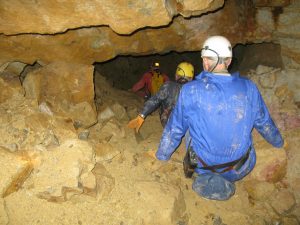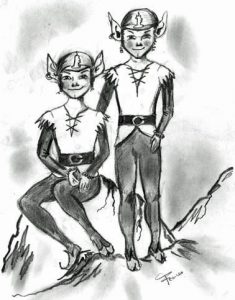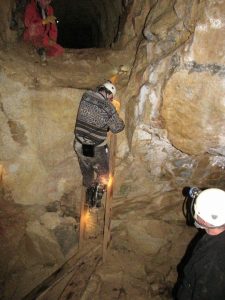
Tony Mansell shares his mining experiences as he takes us underground to four Cornish mines but in particular to Cligga Mine in Perranzabuloe.
I had already been down three Cornish tin mines so the thought of a few hundred feet of granite above me was not of great concern, but those previous trips had been a gentle stroll compared to the voyage of discovery that lay ahead of us.
On a bright, sunny day in August 2010, four intrepid explorers (David James, Gordon McWalter, Trevor Greenslade and myself) crossed the border from St Agnes and entered the neighbouring parish of Perranzabuloe. There, within a few hundred yards of our objective, we met our guides for a never-to-be-forgotten experience.
As we walked the short distance to the cliff top, the vast expanse of the Atlantic Ocean opened out before us, a magnificent sight but one that we would soon leave behind.
A large concrete slab covered the main shaft of Cligga Mine. It seemed to present us with a problem, but a smile spread across the faces of our guides as they explained that there would be no easy descent for us, our entrance was 300 feet below. Before we could enter the subterranean world we had to clamber down the steep cliff face to the beach at sea level. It was a daunting start to our adventure but with the help of some strategically positioned pegs and ropes and a “short cut” which took us into and out of the rock face, we all managed to negotiate the descent safely.
 The Descent
The Descent
Did I mention earlier that I was a “hardened Cornish miner”? Well, I kept that a secret from my friends and our guides but I did let slip the odd phrase or term which I had gleaned from my previous ventures into the bowels of the earth.
My first encounter with the world of Hades had been down Zennor way, just a stomp across the fields from the Tinner’s Arms. The Rosevale Mine is the subject of a restoration project undertaken by volunteers who spend their spare time using traditional methods and materials to preserve the underground workings as an authentic Cornish tin mine. We entered through a horizontal opening and clambered up through the workings to emerge a bit further up the hill. A note on their website says that the question that they are most often asked is “Why do it?” Never one to hold back, it was the very thing that I raised. Looking back, his response was probably delivered with an element of irritation as he asked me what I did on a Saturday afternoon. “I usually watch rugby”, says I.
“Well, we do this”, was his reply.
Fair enough, I thought, as I slumped off to look at another “drive” that was being cut.
Our hosts explained that the mine had never been very profitable, but the surface activity may have “inadvertently” given a different impression to potential investors from London!
It was an interesting and impressive tour and our visit to the Tinners Arms rounded it off nicely.
Wheal Jane was my second venture into mining and it was impressive. I cannot recall how deep we went but it seemed a “brave” way down.
There were lots of items of interest but my eyes immediately alighted on a shiny object that just seemed to shout, “Pick me up”. So I did. It was an attractive chunk of iron pyrite which was destined for my “shelf of interesting items”.
“You can put that down”, I was told by an authoritative voice. I released my grip and it fell to the ground. He handed me a bar and said, “Mine your own, you’ll think more of it”, and for that one brief moment I became a Cornish Miner.
 My piece of Iron Pyrite or “Fool’s Gold”
My piece of Iron Pyrite or “Fool’s Gold”
The size and scope of mining at Wheal Jane was in complete contrast to Rosevale Mine. This was mining on a large scale with large rock-moving machines that must have been assembled underground, stopes high enough to contain Truro Cathedral and tunnels and chutes between levels which went in all directions. Health and Safety was clearly a high priority but to those not used to being underground, it all seemed very precarious.
A few years later I found myself down Crofty, that’s South Crofty. The company for which I worked wanted to take some photographs of me in unusual working situations or as one wag said, “in a working situation!” Anyway, someone had clearly decided to “send him underground”. This may sound blasé, but we only ventured down 500 feet. It all went well until our photographer discovered that we would have to remain there until his camera ceased steaming up in the hot atmosphere. Photographs taken, we eventually left and headed to “grass”.
Before we return to our 2010 expedition we will say a little about the history of the ancient mine of Cligga and its surrounding area and read the accounts of three men who worked there.
Cligga Head (cleger in Cornish) is just over a mile to the south west of Perranporth; it is a granite mass projecting about 300 feet above sea level. In common with this stretch of coastline the cliff face is stained by minerals leeching out from the fissures and perforated with adits which drained the mines down to sea level. The area is littered with reminders of the past; the mining activity, an explosives factory and, more recently, the adjacent Second World War airfield.
Located on this promontory is Cligga Mine. H G Dines’ in his book “The metalliferous mining region of south-west England” says “Old men’s levels in the cliff face in search of tin are common in the northern part of the productive area”. The ancient miners simply identified the metallic veins on the cliff face and began tunnelling along the route of the lode. It is said that the ore was thrown into piles, probably on cowhides, and dragged out of the workings.
Leaving aside the “Old Men” and their workings we leap forward to just prior to the Second World War when Captain Tobias Gribble and Raymond Rogers, both of Chacewater, set up Cligga Wolfram & Tin Mines Ltd and began work under licence from the Duchy of Cornwall. In 1938 ore was being raised and taken to Perrancoombe where it was processed and in the following year, the Rhodesian Mines Trust Ltd became involved and work progressed down to sea level. The West Briton reported in 1939, “The work at Cligga Head is particularly interesting in that the entrance to the mine is at sea level, at the base of the cliff. Tin and wolfram are being recovered, and the miners go to work down the vast side of the cliff, scrambling and sliding their way to the gaping mouth of the adit at the foot. Dotted above them, all over the great height of the old cliff face, stare the adits bored by the ‘old men’ and, at one spot, where the cliff has fallen away, in the course of ages, is revealed the semi-circle of an ancient shaft.”
In October 1941 the “West Briton” reported, “The prospectors started on the side of the steep cliff by driving into old shafts and workings and found sufficient indications of the presence of tin and wolfram in considerable quantities to warrant the commencement of mining operations on a small scale. The small shaft from which the number one level, about 100 feet from surface, was being developed, was sunk a further 100 feet to the number two level, where it was communicated with a drive, approximately 400 feet long, brought in from the face of the cliff. That connection permitted all hoisting to be concentrated in the shaft to the exclusion of the inclined skip road down the face of the cliff…The massive head-gear, which until recently stood at Polberro Mine, St Agnes, has been transferred to Cligga, following suspension of operations on the former property, and re-erected…The shaft has been sunk about 300 feet to sea level and connected with three galleries about 600 feet in length leading out to the cliff edge.”
Joseph Arnold Hodge, Mayor and Freeman of the City of Truro worked at Cligga and recalled some of its recent history.
“Well now, World War Two came but before that everybody knew that something was going to happen sooner or later, particularly in the late 1930s. Hitler was on the go and showing his teeth to everybody. They started to look around for businesses to make warheads and various other things and you’ve got to have the stuff for it and the only place was Cornwall. Groups of miners who had very little money, even if they had jobs they didn’t get much, used to go to these old mines and work what we called hard labour – by beating the drill with a hammer and breaking the stuff out. They took it away to a firm called Stewarts at Portreath Road – where the Gold Centre is now. They would buy it and process it – the miners had no way of processing it themselves at first but later there was a waterwheel stamps and a table down at Perrancoombe and by doing it there, with water nearby, they could process it themselves. Cligga was a rich little mine; they would get out wolfram which was very highly sought after for guns and warheads. By this time the war had started and what we couldn’t get from Cornwall, we couldn’t get.
Captain Gribble and a man called Rogers had opened up Cligga. To start with, when I went out there first, they had a single skip road – that’s one skip going up and down – and they were down to about 100 feet, that was the shaft that we were working in. Other shafts were deeper but the one that they wanted to work was about 100 feet deep. It was a successful little mine so they decided to sink a further 100 feet to about 200 feet. The sea level was about 300 feet below the top of the cliff. Now, the problem of Cornwall as a mining county will always be water – it cost a fortune to get it out. Our strata makes a tremendous amount of water; you couldn’t put an ordinary little pump in, it needed a Cornish pump. But at Cligga we had 300 feet that would drain itself – straight into the sea. That meant that they didn’t go any deeper than 300 feet apart from a little sump. But we had to have water for the steam engine, you can’t use salt water for steam engines – it’ll rust out. But you can use it for a lot of other things on the mine – tin dressing and all that. So what they did was, down on Cligga Beach, they built a pumping station and that pumped up water to a very large concrete tank and the salt water was used for general purposes throughout the mine.
There are three tunnels that drain the mine – one from each level – 100 feet, 200 feet and 300 feet down the cliff face, the bottom one was near enough at sea level. Now we still had to have fresh water and when I went out there first there was an old man who lived out Trevellas who used to carry water in a pony and barrel. The barrel was fixed between two cartwheels and he used to bring in enough water to run the steam engine that we had at that time. That was all right while we were 100 feet deep – we weren’t producing much. When we got deeper, then we had to have a bigger mill to dress the stuff. They decided then that they would get a steam engine to drive the mill. That required more fresh water so what they did, they went down Coombe, that’s Perrancoombe, and put a ram in and then ‘drove grass’ – pumped it to the top. It was pumped right up across the fields, up behind St George’s Hotel, across the road, up the factory gates and out to Cligga. There was another reservoir on the other side of the road into the mine and this was used for steam. Cligga was mostly wolfram plus a little tin. The mill would work day and night – so would the miners and at the end of each shift they would have a certain amount of clean mineral. That was bagged and put in the tin yard. When we had enough we would send it up country in a lorry – that was weekly or maybe more often. At that time Cligga was only 300 feet deep. As soon as they went below 300 feet they had trouble – the tide would come in so instead of going deeper they spread out – back under the aerodrome. If they had gone on any longer they would have had to have gone deeper. It’s a lot deeper now since Geevor opened it up. The RAF considered the Mine to be a landmark – one building stretched for quarter of an acre – it was lit up all night and we had to ‘black out’ everything which was difficult with doors opening and men going to and fro from the crusher.”
Richie Sandercock of St Agnes gave an interesting account of his time there from 1939, at the age of 15.
“We worked the mine down to the 300 level, to where it would drain naturally through the adits. I only remember two accidents while I was working there, one was a shift boss who broke both legs and the other was me. We were making a box hole or header, that’s where a vertical shaft is cut up from a level. It may be about 12 feet square and could extend right up to the next level, depending on the lodes. Out of this shaft would be the stopes which were driven sideways – following the mineral. I was making up the timberwork and a large rock fell on my back. They sent out an ambulance from Goonown and Dr Cuthbert Whitworth came out to tend me but I wasn’t badly hurt. You could always tell when things were going well, someone would start to sing a hymn or a carol and it would be picked up by the men all along the tunnels. George Wills was a good singer but he could lose his cool occasionally. I remember when we had some Russian timber, the stuff was so hard that you couldn’t cut it with a saw and you had to drill holes for the nails. As George was trying to work it, bits of granite were flying off and stinging his arms. He got so fed up that he picked up his hammer and threw it as far as he could. He did this a few times and it was my job to go and fetch it back. If we were working underground during the day we could walk out through the adits and up the cliff paths but at night we had to climb up the shaft ladders to the surface, otherwise enemy planes might have spotted our lights. Being so close to the airfield, everything above ground had to be blacked out. One night a month we had to go on fire patrol and on one occasion I was there with my brothers, Bill and John. We were in the foreman’s office when a German plane dropped some incendiary bombs; luckily they were on the edge of the cliff and fell into the sea.”
An amusing story from wartime Cligga involved Carlos Gribble, the mine surveyor. Cligga Mine is next to Trevellas Airfield, termed RAF Perranporth during the Second World War. Gaining access to the mine at that time meant having to pass through a security area. Carlos Gribble was well-known to everyone at the mine and to those tasked with the security of the airfield. Despite that, when he arrived at the gate he was always challenged to identify himself. On one occasion the duty guard was a local chap called Sammy Keast. Sammy always used the customary challenge “Friend or foe?” to which, on this occasion, Mr Gribble answered, “Foe”. The exasperated guard said, “Look Mr Gribble, I’ll ask you again,” only to receive the same answer. Resigned to defeat Sammy replied, “Oh, come on in then”.
John Gribble of Chacewater, a grandson of Captain Tobias Gribble, recalled his time at Cligga in 1962 and 1963 when he was involved in deepening the shaft.
“I was working for Foraky Ltd, a shaft sinking company. We started at 300 feet – the old bottom level where the tunnels come out on the beach. We had to cut a twelve feet by six feet exploratory shaft and I worked on it down to the 500 feet level (it eventually extended to 550 feet below surface). There were four men working in that small space, each with his rock drill and air and water supply – it was a bit congested. The usual pattern of work was to clear the rubble from the last blasting until there was a clean base. We than started drilling, first with three feet long bits, then with six feet and finally with nine feet bits. To save time we often missed out the shorter one but the drill was a bit unwieldy and it was difficult to collar the hole. When we’d finished the drilling the explosives were placed and we’d retire to a safer level or, more probably, leave work and the next shift would clear our muck. Of course, our progress varied with the hardness of the rock encountered. I remember one incident when we were lucky to get out alive and if it wasn’t for the skill of the whim driver it might have been a different story. We were working at about 500 feet and had just filled the kibble – it was being hauled to the surface when it snagged. The ends of the old tunnels – where they met the shaft – had been boarded up and metal guides fixed to make sure the kibble ran smoothly past these points. At the 100 feet level the kibble caught the end of one of these guides and dragged it off, pulling away the timber boarding and the build-up of rubble behind. We heard the commotion and immediately pressed our backs to the wall as boulders up to one foot in diameter plummeted down the shaft. One of the chaps fell into the centre of the pit and we managed to pull him back to the relative safety of the perimeter. Luckily for us, the boards jammed against the shaft sides otherwise they would have come down like missiles. The whim driver must have realised what had happened because he immediately stopped with the kibble still in the shaft and still loaded with stone. Once the dust had cleared we were able to take stock of the situation; we had two men injured and the bell rope had been ripped from the wall – we had no way of communicating with the whim driver. Suddenly, inch-by-inch, the kibble began to move back down the shaft, threading its way past the displaced timber. John Allen, from Blackwater, was a first-class whim driver who relied less on our signals than his own skill at judging the kibble location from the markings he’d made on the whim wheel and the steel rope. He brought the kibble to within six inches of the shaft bottom and it was only when the four of us had clambered on, and he’d detected that our weight had stretched the rope and taken the kibble to the ground, that he started the slow, upward journey. Once again, with pinpoint accuracy, he stopped at the 300 feet level where we were met by our rescuers who had come in through the adit at beach level. A slight fracture of the skull and a broken leg was the total of our injuries but from then on there were some anxious faces whenever there was an unusual noise from above.”
In 1972, International Tin Services spent some time sampling the mine and in 1985, Concord Mines proposed to re-open it, but this was discontinued when the tin price collapsed, making it no longer viable.

History lesson completed we now return to the 2010 expedition and as we entered the level three adit, at beach level, we noticed a sign above the portal: it was almost illegible but we could just make out that it said “Danger” or maybe it was “Dragons”. Undaunted, we ventured on, and as the natural light faded we switched on the torches on our helmets. Mining paraphernalia lay all around us: half-covered rail tracks, wagons, broken drill bits and pipework of all shapes and sizes.
Overhead, the stopes soared upwards with their rock faces still supported by timber props while Cousin Jack chutes (for loading wagons) defiantly held back piles of broken rock.

 A “Cousin Jack” Chute
A “Cousin Jack” Chute
Cligga Mine has a recent and an ancient history with “Old men’s workings” still evident. We were warned that it would be unwise to venture into the tunnels created by the miners of centuries ago. This was probably for safety reasons but could it have been that we may have disturbed the spirits of the ancient workers? Apparently, there is a ghost which walks the tunnels but we never actually met him or her.
Our first hour of exploration consisted of walking, crawling, climbing and sliding around the three levels and there were points of interest every few yards. None of us were in the prime of youth but the difficulty in manoeuvring ourselves over and around the obstacles was masked by our fascination with the technology and the history. At last, there was some respite as we entered a cavernous area appropriately dubbed the “Hard Rock Café”. Yes, it was there that we sat on the rocks and tucked into whatever goodies our wives had packed for us. For me, it was a home-made pasty, just like the miners had undoubtedly done. The only difference was that mine was not wrapped in muslin but, like them, I ate it from end to end and not by holding onto the crust which is what some would have us believe is the way to tackle it! Like those early miners I knew the importance of leaving a corner of pasty for the Cornish knockers and when we returned to that area the tasty morsel had gone, proving, ipso facto, that Cornish Knockers do exist.
 The Hard Rock Café
The Hard Rock Café
 The grateful Cornish Knockers
The grateful Cornish Knockers
We were underground for three to four hours and apart from our brief stop for sustenance, we were on the move for the whole time. At one point we emerged through a hole in the cliff face and found that we had climbed to about 100 feet above our entrance point. The panoramic view was stunning, the same view that generations of Cornish miners had observed. It was an experience that will remain with us for a long time.
 A distant view of Bawden Rocks (“Cow and Calf”) through an opening in the cliff face
A distant view of Bawden Rocks (“Cow and Calf”) through an opening in the cliff face
We continued our exploration with boyish excitement, slithering through small gaps, struggling over mountains of broken stone and climbing a rotten wooden ladder that stopped about two feet short of the next level. At one point we crept by a huge slab of granite that seemed ready to detach itself at any moment. “Don’t hang around there,” was the sound advice from our guides. We did not!
 Me and the ladder
Me and the ladder
During the trip we suffered just one small accident; one of us had trapped his foot and tumbled backwards. It could have been nasty, but it wasn’t and when I reached home my wife offered her sympathy with, “I knew it would be you!”
Finally, it was time to leave, and we made our way back down to level three and headed for the light at the end of the tunnel (sorry about that!). We emerged with smiles of satisfaction on our faces but then remembered that we had to climb back up the 300 feet high cliff face. There was no alternative, and after a brief pause to catch our breath, we began the ascent. By now, our tired legs had acquired minds of their own and with efforts focussed on keeping them going forward we had little time for the stunning views. Eventually, we made it to the top and trudged back to our cars.
It really is a fascinating world down there and, despite the exhaustion and the days of aching muscles, none of us would have missed it. I know that if another group want to make the trip then I will be there with them…waving goodbye from the top of the cliff!
Glossary:
Cornish Knockers: Little people who live in the mines and, in return for a corner of pasty, keep you safe from harm. Not to be confused with fairies, goblins or leprechauns which are all mythical!
Drive: Extending a mining tunnel.
Grass: Above ground at a mine or Bal. “Up to grass”, to return to the surface of a mine.
Old Men’s Workings: Excavations by the mine workers of past centuries.
References:
“Jericho to Cligga” by Clive Benney and Tony Mansell (Pub: Trelease Publications ISBN 0-9545583-6-7
Photographs:
Trevor Greenslade and Tony Mansell


Great reading and, perhaps more importantly, an excellent record of underground trips, to keep alive memories of arguably the most visible, intriguing, and worthy, of our ancient industries. Well done Tony Mansell and well done “Cornish Story”!
A fascinating account of your trip down a mine. I enjoyed the accounts from the miners who worked the mines.
Thank you Teresa